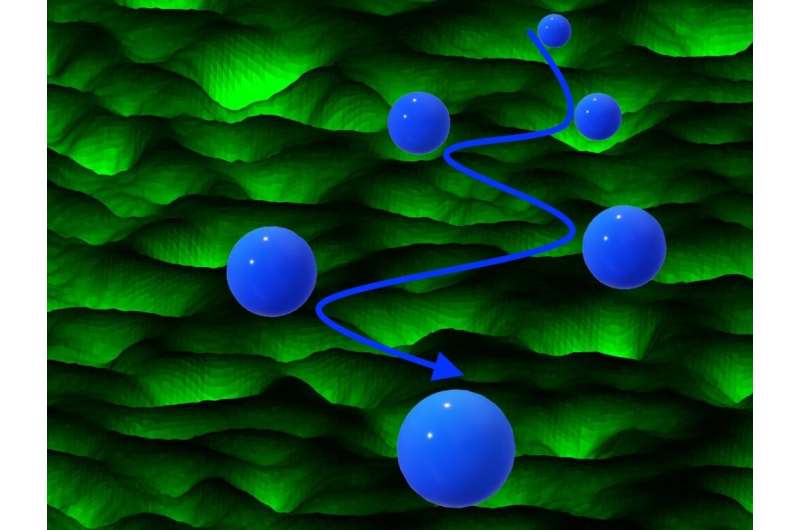Challenging Einstein's picture of Brownian motion

Around a decade ago, the discovery of Fickian yet non-Gaussian Diffusion (FnGD) in soft and biological materials broke up the celebrated Einstein's picture of Brownian motion. To date, such an intriguing phenomenon is still unexplained due to the major experimental challenges posed by the complex and heterogeneous nature of the underlying materials. To overcome these difficulties, researchers at the University of Naples Federico II (Italy) have now exploited light in place of complex matter to create a heterogeneous environment for particles diffusing in water. The work, now published in Physical Review Letters, stems from a collaboration between the group of Statistical Mechanics of Soft Materials at the Dept. of Chemical, Materials and Production Engineering and the laboratory of Laser Spectroscopy and Optical Manipulation at the Dept. of Physics.
In this experiment, a laser beam passes through a liquid-crystal "Spatial Light Modulator" giving rise to a heterogeneous light pattern. The light pattern is then projected over a system of micron-sized glass beads in water, acting on the particles as a force field (optical forces). The "Spatial Light Modulator" allows for varying the pattern properties with high precision and digital control. Due to the interplay between optical forces and thermal collisions with water molecules, the beads explore the light pattern as if they were moving over a rough surface. As a matter of fact, the light is able to mimic the heterogeneous structure of soft materials but with much higher control and reproducibility if compared to "real" materials. The research team shows that this experimental setup is indeed able to finely reproduce the phenomenology of FnGD over an unprecedented range of timescales and displacement probability, also revealing novel features of this phenomenon.
A memory effect of earlier subdiffusion
The restless dance of microscopic particles due to thermal collisions with the molecules of the environment has fascinated researchers since the discovery of Brownian motion, being responsible for diffusion, the most important and widespread form of transport process. According to Einstein's work on standard Brownian motion, the steps of this dance form a random walk, so implying that the particle mean square displacement (MSD) increases linearly in time (Fickian) and the displacement distribution is a Gaussian, as confirmed by a wide variety of experiments. Conversely, correlated walks (for example, made up by back-and-forward steps) give rise to anomalous diffusion, found to be non-Fickian and non-Gaussian. Thus, Fickian and Gaussian behavior were thought to be intimately related.

In 2009 at the Granick's Lab (University of Urbana, Illinois), groundbreaking experiments on nanometric beads in complex biological fluids broke up such well-established scenario, revealing the existence of a novel type of diffusion that is distinct from both standard Brownian motion and anomalous diffusion, being simultaneously Fickian but Non-Gaussian. Since then, such a Fickian yet non-Gaussian diffusion has been found in a wide variety of heterogeneous environments, mainly soft matter systems.
The experimental strategy now elaborated at the University of Naples reveals that FnGD is preceded by an earlier anomalous diffusion (subdiffusion), and that the two regimes are closely tangled. This leads to interpret FnGD as a memory effect: The memory of anomalous diffusion survives longer in the displacement distribution than in the MSD, leading to the temporary coexistence of Fickian and non-Gaussian behaviors. Raffaele Pastore and colleagues deem that the introduced model-system opens the way to extensive and finely tunable experiments on FnGD. The possibility of easily visualizing a large number of long trajectories will hopefully unveil the features of the Brownian dance underlying the counterintuitive coexistence of Fickian but non-Gaussian dynamics.
More information: Raffaele Pastore et al. Rapid Fickian Yet Non-Gaussian Diffusion after Subdiffusion, Physical Review Letters (2021). DOI: 10.1103/PhysRevLett.126.158003
Journal information: Physical Review Letters
Provided by University of Naples Federico II





















